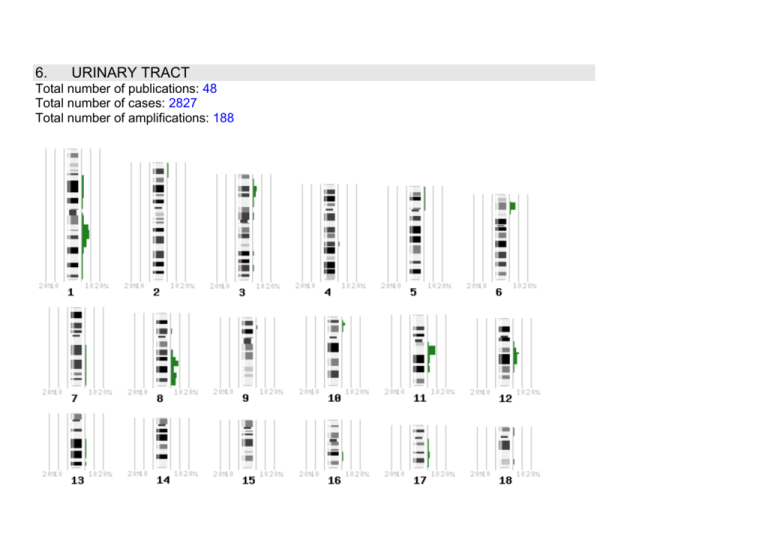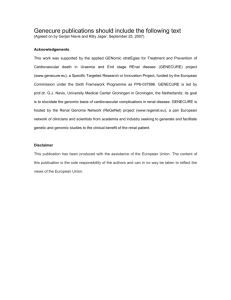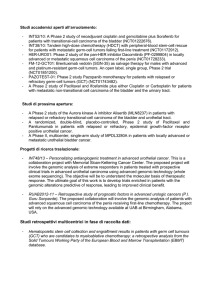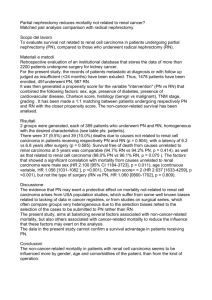Urinary tract
advertisement

6. URINARY TRACT Total number of publications: 48 Total number of cases: 2827 Total number of amplifications: 188 Tumor 6.1 Loss Renal cell carcinoma Amplicon 1 1p 2 3 3p 3p21-pter 6 6p12-p22 6q 8 8p 8p21.3-pter 9p 9p13-pter 9q21-qter* 10 10q 13 Percentage (number of cases) 13 (7/56) 35 (19/55) 31 (23/75) 21 (4/19) 50 (20/40) 71 (29/41) 59 (20/34) 4 (1/25) 17 (7/41) 21 (4/19) 20 (3/15) 18 (12/66) 28 (11/40) 24 (10/41) 17 (11/66) 59 (20/34) 12 (5/41) 65 (22/34) Amplified genes (studied from the same cases) Reference 1,2 3-5 1,2,4 4 1,3 2 1,4 3 2 4 1 2,3 1,3 2 2,3 1,4 2 1,4 13q14.3-qter 14q21-qter 17 17p 17q 18 21 X Xq11-q25 Xq26-qter Y Additional references 6.1 6.1 6.1 6.1 Renal cell carcinoma RENAL CELL CARCINOMA (1/27 cases) amp(11q22q23) 17 (11/66) 26 (17/66) 68 (13/19) 12 (6/52) 27 (4/15) 18 (10/55) 23 (20/86) 15 (5/34) 12 (3/25) 20 (8/41) 20 (17/85) None 0 (0/41) 2,3 2,3 4 2,5 1 3-5 1,2,4,5 1,4 3 2 2-4 6,7 2 Bissig H, Richter J, Desper R, Meier V, Schraml P, Schäffer AA, Sauter G, Mihatsch MJ, Moch H: Evaluation of the clonal relationship between primary and metastatic renal cell carcinoma by comparative genomic hybridization. Am J Pathol 1999, 155:267-274. RENAL CELL CARCINOMA (0/116 cases) Jiang F, Desper R, Papadimitriou CH, Schaffer AA, Kallioniemi O-P, Richter J, Schraml P, Sauter G, Mihatsch MJ, Moch H: Construction of evolutionary tree models for renal cell carcinoma from comparative genomic hybridization data. Cancer Res 2000, 60:6503-6509. RENAL CELL CARCINOMA (?/6 cases) Comment: Amplifications were not determined. Kanayama H-O, Lui W-O, Takahashi M, Naroda T, Kedra D, Wong FK, Kuroki Y, Nakahori Y, Larsson C, Kagawa S, Teh BT: Association of a novel constitutional translocation t(1q;3q) with familial renal cell carcinoma. J Med Genet 2001, 38:165-170. 6.1 6.1 6.1 6.1 6.1 6.1 6.1 RENAL CELL CARCINOMA (0/13 cases) Izumi H, Hara T, Oga A, Matsuda K, Sato Y, Naito K, Sasaki K: High telomerase activity correlates with the stabilities of genome and DNA ploidy in renal cell carcinoma. Neoplasia 2002, 4:103-111. RENAL CELL CARCINOMA (?/46 cases) Comment: Amplifications were not determined. Junker K, Moravek P, Podhola M, Weirich G, Hindermann W, Janitzky V, Schubert J: Genetic alterations in metastatic renal cell carcinoma detected by comparative genomic hybridization: correlation with clinical and histological data. Int J Oncol 2000, 17:903-908. Renal cell carcinoma, Not 5 papillary determined Renal cell tumor Not 7 determined RENAL CANCER (1/61 cases) amp(2q22q33,16q,7q,X) Reutzel D, Mende M, Naumann S, Storkel S, Brenner W, Zabel B, Decker J: Genomic imbalances in 61 renal cancers from the proximal tubulus detected by comparative genomic hybridization. Cytogenet Cell Genet 2001, 93:221-227. RENAL CELL NEOPLASM (?/4 cases) Comment: Amplifications were not determined. Gronwald J, Baur AS, Holtgreve-Grez H, Jauch A, Mosimann F, Jichlinski P, Wauters JP, Cremer T, Guillou L: Chromosomal abnormalities in renal cell neoplasms associated with acquired renal cystic disease. A series studied by comparative genomic hybridization and fluorescence in situ hybridization. J Pathol 1999, 187:308312. RENAL MEDULLARY CARCINOMA (0/40 cases) Swartz MA, Karth J, Schneider DT, Rodriguez R, Beckwith JB, Perlman EJ: Renal medullary carcinoma: clinical, pathologic, immunohistochemical, and genetic analysis with pathogenetic implications. Urology 2002, 60:1083-1089. 6.1 6.1 6.1 6.1 6.1 6.1 TUBULAR-MUCINOUS RENAL NEOPLASM (?/5 cases) Comment: Amplifications were not determined. Rakozy C, Schmahl GE, Bogner S, Störkel S: Low-grade tubular-mucinous renal neoplasms: morphologic, immunohistochemical, and genetic features. Mod Pathol 2002, 15:1162-1171. RENAL PELVIS CARCINOMA, TRANSITIONAL (5/10 cases) amp(1q21q25)/amp(2p23p25,12q14q15,12q23q24)/amp(6p22p23)/amp(8q22q24.1,11q13,12q14q21)/amp(8q 21q22,11q13) Rigola MA, Fuster C, Casadevall C, Bernués M, Caballín MR, Gelabert A, Egozcue J, Miró R: Comparative genomic hybridization analysis of transitional cell carcinomas of the renal pelvis. Cancer Genet Cytogenet 2001, 127:59-63. RENAL ONCOCYTOMA (?/28 cases: 21 cases sporadic and 7 familial renal oncocytomas) Comment: Amplifications were not determined. Junker K, Weirich G, Moravek P, Podhola M, Ilse B, Hartmann A, Schubert J: Familial and sporadic renal oncocytomas – a comparative molecular-genetic analysis. Eur Urol 2001; 40:330-336. KIDNEY SPIRADENOCYLINDROMA (?/1 case) Comment: Amplifications were not determined. Ströbel P, Zettl A, Ren Z, Starostik P, Riedmiller H, Störkel S, Müller-Hermelink HK, Marx A: Spiradenocylindroma of the kidney: clinical and genetic findings suggesting a role of somatic mutation of the CYLD1 gene in the oncogenesis of an unusual renal neoplasm. Am J Surg Pathol 2002, 26:119-124. MESOBLASTIC NEPHROMA (?/1 case) Comment: Amplifications were not determined. Guschmann M, Tönnies H, Bührer C, Mau H, Vogel M: Myoid differentiation in mesoblastic nephroma: Clinicopathologic and cytogenetic findings of a rare case. J Pediatr Surg 2002, 37:E22. KIDNEY TUMORS (?/8 cases) Comment: Amplifications were not determined. Rigola MA, Casadevall C, Bernués M, Caballín MR, Fuster C, Gelabert A, Egozcue J, Miró R: Analysis of kidney tumors by comparative genomic hybridization and conventional cytogenetics. Cancer Genet Cytogenet 2002, 137:49-53. 6.1 RENAL CELL CARCINOMA REVIEW Moch H, Mihatsch MJ: Genetic progression of renal cell carcinoma. Virchows Arch 2002, 441:320-327. 6.1 Renal cell carcinoma: 8 amplifications out of 377 cases 6.2 Wilms' tumor None 3q11-q13.3 4q21-qter 9p13-pter 11p13-p15* 16q 17p 20p 0 (0/54) 38 (3/8) 50 (4/8) 50 (4/8) 11 (6/54) 17 (9/54) 13 (7/54) 38 (3/8) 6.2 Wilms' tumor Not determined 6.2 WILMS’ TUMOR (5/79 cases) amp(1q12q25)/amp(1q)/amp(1q)/amp(1q21q31)/amp(1p13q31) Comment: 5/58 relapsing Wilms’ tumors: amp(1q12q25)/amp(1q)/amp(1q)/amp(1q21q31)/amp(1p13q31) 0/21 nonrelapsing Wilms’ tumors 8,9 8 8 8 8,9 8,9 8,9 8 10 Hing S, Lu Y-J, Summersgill B, King-Underwood L, Nicholson J, Grundy P, Grundy R, Gessler M, Shipley J, Pritchard-Jones K: Gain of 1q is associated with adverse outcome in favorable histology Wilms' tumors. Am J Pathol 2001, 158:393-398. 6.2 Wilms tumor: 5 amplifications out of 133 cases 6.3 Bladder carcinoma 1p32 2q24-qter* 3p13-p14 3p21 3p21.1-p21.3 3p22-p24 3q24 4p11-p14 4q26 5q21-q22 6p22 6q25.1-qter 8p21-pter* 8q21.3-qter 9p* 9q 9q13-qter* 10p13-p14 10q23-qter* 11p12-p15* 11q14-q22 11q22.2-qter* 12q13-q15 12q15 12q21-q24 12q23-qter 13q13-q14 13q21-q31 14q11.1-q24.3 14q24-qter* 15q21 6 (1/16) 20 (19/95) 23 (3/13) 6 (1/16) 23 (6/26) 7 (1/14) 6 (1/16) 23 (3/13) 6 (1/16) 13 (7/53) 6 (2/33) 15 (4/26) 24 (23/95) 6 (2/32) 25 (13/53) 31 (4/13) 33 (32/96) 7 (1/14) 14 (13/95) 25 (13/53) 6 (1/16) 21 (23/109) 7 (1/14) 6 (1/16) 6 (1/16) 23 (6/26) 23 (3/13) 6 (1/16) 12 (3/26) 13 (5/40) 15 (4/27) 11 12-14 14 11 12 15 11 14 11 12,13,15 12,16 12 12-14 11,12 12,14,15 14 12,13,15 15 12-14 12,14,15 11 12-15 15 11 11 12 14 11 12 12,15 14,15 16p11-pter* 16q21-q22 16q21-qter* 17p 17q22-q23 18p11 18q22 20q12-qter 22q11-13 Y 6.3 Bladder carcinoma 1p32 3p21 3q24 4q13-q23 4q26 5q13-q21 8p21-p22 8q21-qter 9p21-p23 9q21 11p14 11q14-q22 12q15-q21 12q21-q24 13q21-q31 17q22 18q22 14 (13/95) 14 (1/7) 15 (6/40) 11 (10/95) 7 (2/30) 7 (1/14) 6 (1/16) 4 (1/26) 7 (1/14) 19 (18/95) 6 (1/16) 6 (1/16) 6 (1/16) 19 (3/16) 6 (1/16) 25 (4/16) 25 (4/16) 6 (1/16) 31 (5/16) 31 (5/16) 19 (3/16) 6 (1/16) 6 (1/16) 6 (1/16) 6 (1/16) 6 (1/16) 6 (1/16) 12-14 16 12,15 12-14 11,15 15 11 12 15 12-14 11 11 11 11 11 11 11 11 11 11 11 11 11 11 11 11 11 6.3 6.3 6.3 BLADDER CANCER, PRIMARY (?/17 cases) Comment: Number of cases was not clearly defined, but high-level amplifications were present at 1q12q25, 10q22.1q23.1, 11q11q14.1, 17q11q21.3, and 20q11.2qter. Hovey RM, Chu L, Balazs M, DeVries S, Moore D, Sauter G, Carroll PR, Waldman FM: Genetic alterations in primary bladder cancers and their metastases. Cancer Res 1998, 58:3555-3560. Bladder carcinoma, low- 2q35-qter 10 (11/113) 18 grade papillary noninvasive 4p14-p15.1 5 (6/113) 18 5q13.2-q23 6 (7/113) 18 5q32-qter 7 (8/113) 18 6q25-qter 6 (7/113) 18 8p12-p21 9 (10/113) 18 8p12 2 (2/113) 18 9p 37 (42/113) 18 9q21.2-q22.1 43 (49/113) 18 10p13 1 (1/113) 18 10q24-q25 8 (9/113) 18 11p13 10 (11/113) 18 11q13 2 (2/113) 18 11q22-qter 9 (10/113) 18 13q21 3 (3/113) 18 14q21-q24 3 (3/113) 18 16q22-qter 3 (3/113) 18 17p 3 (3/113) 18 18q21 12 (14/113) 18 Xp 4 (4/113) 18 Xq21 3 (3/113) 18 Xq21 1 (1/113) 18 Bladder carcinoma, 1q21-q25 2 (1/56) 13 papillary 6.3 6.3 6.3 1q21-q31 2 (1/56) 3p22-p25 4 (2/56) 6p22 4 (2/56) 8pcen-p12 2 (1/56) 8q21-q22 4 (2/56) 10p12.1-p14 2 (1/56) 11q12-q14 2 (1/56) 11q13 2 (1/56) 12q15-q21 2 (1/56) 13q31-q33 2 (1/56) Xp11-p13 2 (1/56) Xq21-q22.2 2 (1/56) BLADDER CANCER, PAPILLARY (?/30 cases) Comment: Number of cases was not clearly defined, but high-level amplifications were detected at 5p11p13, 6p22pter, 7q32qter, 11q13, 16p12pter, and 20p13pter. 13 13 13 13 13 13 13 13 13 13 13 13 1p11p13, Prat E, Bernués M, Caballín MR, Egozcue J, Gelabert A, Miró R: Detection of chromosomal imbalances in papillary bladder tumors by comparative genomic hybridization. Urology 2001, 57:986-992. BLADDER CANCER, INVASIVE (?/67 cases: 37 solid muscle invasive and 30 minimally invasive) Comment: Number of cases was not clearly defined, but high-level amplifications were found at 1q21q24, 1q21q25, 3p24pter, 8q21.3q22, 10p11.2p12, 10p13pter, 10q24q26, 11q13, 12q12q13, 17q11.2q21, and 17q23qter in solid muscle invasive cancer and at 1q21q24, 1q21q25, 3p12p13, 3p22p24, 5p12p13, 5p15.1pter, 6p21.3p23, 8q21.3, 8q21.3q22, 8q24.1, 9p22pter, 17q11.2q21, 17q22q23, 17q24q25, 17q25, 18p11.3, 20q11.2q13.1, and Xp11.4p21 in minimally invasive bladder cancer. Simon R, Burger H, Semjonow A, Hertle L, Terpe HJ, Bocker W: Patterns of chromosomal imbalances in muscle invasive bladder cancer. Int J Oncol 2000, 17:1025-1029. BLADDER CANCER (?/32 cases) Comment: Amplifications were not determined. Simon R, Eltze E, Schäfer KL, Bürger H, Semjonow A, Hertle L, Dockhorn-Dworniczak B, Terpe HJ, Böcker W: Cytogenetic analysis of multifocal bladder cancer supports a monoclonal origin and intraepithelial spread of tumor cells. Cancer Res 2001, 61:355-362. 6.3 6.3 6.3 BLADDER CANCER (?/123 cases) Comment: Amplifications were not determined. Moore LE, Smith AH, Eng C, Kalman D, DeVries S, Bhargava V, Chew K, Moore D 2nd, Ferreccio C, Rey OA, Waldman FM: Arsenic-related chromosomal alterations in bladder cancer. J Natl Cancer Inst 2002, 94:16881696. BLADDER CANCER (?/118 cases) Comment: Amplifications were not determined. Junker K, Kania K, Fiedler W, Hartmann A, Schubert J, Werner W: Molecular genetic evaluation of fluorescence diagnosis in bladder cancer. Int J Oncol 2002, 20:647-653. Bladder carcinoma, 1q22-q24 2 (1/54) 19 invasive urinary 1q32 17 (1/6) 20 2q22-q33 11 (6/54) 19 2q35-qter 17 (9/54) 19 3p12 2 (1/54) 19 3p22-p24 4 (2/54) 19 4q26-qter 15 (8/54) 19 5p14-p15 17 (1/6), 19,20 2(1/54) 5q15-q23 15 (8/54) 19 6p22 6 (3/54) 19 6q22-q23 13 (7/54) 19 8p 24 (13/54) 19 8q22 4 (2/54) 19 8q24 2 (1/54) 19 9p 32 (17/54) 19 9q22-q33 28 (15/54) 19 10p13 4 (2/54) 19 10q24-qter 15 (8/54) 19 11p14-pter 28 (15/54) 19 11q13 6 (3/54) 19 11q23 12q15 13q31 13q33-q34 14q24-q31 16q12-qter 17p 18q12-qter Xpter-q22 Xp21 6.3 6.3 Y BLADDER CARCINOSARCOMA, URINARY (?/1 case) Comment: Amplifications were not determined. 26 (14/54) 2 (1/54) 19 (10/54) 2 (1/54) 9 (5/54) 7 (4/54) 11 (6/54) 9 (5/54) 11 (6/54) 2 (1/54) 26 (14/54) Gronau S, Menz CK, Melzner I, Hautmann R, Moller P, Barth TFE: Immunohistomorphologic and cytogenetic analysis of a carcinosarcoma of the urinary bladder. Virchows Arch 2002, 440:436-440. Bladder carcinoma, small 1p22-p32 20 (2/10) cell 2q21-q23 30 (3/10) 3p 30 (3/10) 3q26.3 10 (1/10) 4q32-qter 50 (5/10) 5qcen-q23 50(5/10) 8p 40 (4/10) 8q24 10 (1/10) 10q21-q23 70 (7/10) 12q14-q21 10 (1/10) 13q13-q22 40 (4/10) 19 19 19 19 19 19 19 19 19 19 19 molecular 21 21 21 21 21 21 21 21 21 21 21 6.3 6.3 6.3 6.3 6.3 6.3 BLADDER CANCER, BILHARZIA-ASSOCIATED (0/20 cases) Fadl-Elmula I, Kytölä S, Leithy ME, Abdel-Hameed M, Mandahl N, Elagib A, Ibrahim M, Larsson C, Heim S: Chromosomal aberrations in benign and malignant Bilharzia-associated bladder lesions analyzed by comparative genomic hybridization. BMC Cancer 2002, 2:5. Not determined Bladder carcinoma, 14 transitional cell Bladder carcinoma, None 0 (0/10) 22 schistosoma-associated transitional cell Bladder carcinoma, non1q23-q24 8 (1/13) 22 schistosoma-associated transitional cell 20q 8 (1/13) 22 BLADDER CANCER, SCHISTOSOME-RELATED TRANSITIONAL (?/28 cases) Comment: Number of cases was not clearly defined, but high-level amplifications were found at 1q21q22, 1q21q23, 2p23p25, 2q11.2q14.3, 3p22p24, 3q26.1q26.3, 6p22, 6q16q21, 7p21, 7q21q22, 7q32, 8q21q22, 8q22q23, 8q22, 8q23qter, 9p13p22, 11q13, 12p11.2p12, 12q14q21, 12q21, 12q24.1q24.3, 15q25qter, 18p11.2pter and 19q13.1q13.2. Muscheck M, Abol-Enein H, Chew K, Moore D 2nd, Bhargava V, Ghoneim MA, Carroll PR, Waldman FM: Comparison of genetic changes in schistosome-related transitional and squamous bladder cancers using comparative genomic hybridization. Carcinogenesis 2000, 21:1721-1726. Bladder carcinoma, 3p12 21 (6/28) 22 schistosoma associated squamous 4q24-q31 29 (8/28) 22 5p 4 (1/28) 22 5q15-q21 21 (6/28) 22 8p 11 (3/28) 22 8q24 4 (1/28) 22 9p21-pter 21 (6/28) 22 11q13 4 (1/28) 22 12q14-q15 12q15 6.3 6.3 Bladder carcinoma, nonschistosoma associated squamous 13q21-q22 13q21-q31 4 (1/28) 4 (1/28) 39 (11/28) 28 (5/18) 22 22 22 22 8q24 11 (2/18) 22 11q13 6 (1/18) 22 BLADDER CANCER, SQUAMOUS (?/26 cases) Comment: Number of cases was not clearly defined, but high-level amplifications were found at 1p21p22, 1p31, 1q23q24, 7p14p15, 7q21q31, 8q22q23, 8q22, 11q12q13, 11q22, 14q12q21 and 20p12p13. Muscheck M, Abol-Enein H, Chew K, Moore D 2nd, Bhargava V, Ghoneim MA, Carroll PR, Waldman FM: Comparison of genetic changes in schistosome-related transitional and squamous bladder cancers using comparative genomic hybridization. Carcinogenesis 2000, 21:1721-1726. 6.3 Bladder carcinoma: 167 amplifications out of 846 cases 6.4 UROEPHITELIAL TUMORS (?/1352 cases) Comment: Amplifications were not determined. Toncheval DI, Atanassova SY, Gergov TD, Todorovska EG, Roeva IG, Georgiev TH, Fink-Gremmels J, Zaharieva BM: Genetic changes in uroepithelial tumors of patients with Balkan endemic nephropathy. J Nephrol 2002, 15:387-393. Concerning Losses: 10% of the cases must be aberrant and the number of aberrant cases at least three; findings in parentheses are examples of highly frequent aberrations that fail to meet the 3 cases/10% criteria; Boldface indicates that more than 30% of the cases detected in a study of at least 10 cases were aberrant; *Description of a region, e.g. 6q21-q22, implies that in a variety of cases the loss was located within the area but it did not necessarily affect the whole area in all cases. The described regions may therefore not be considered analogous with minimal overlapping area. Furthermore, in some single cases the loss area may extend beyond the region described. As a whole, the description should be considered a flexible way to summarize critical areas of recurrent DNA copy number changes in that particular tumor type. Description without an asterisk indicates minimal overlapping areas. Concerning Amplicons: Boldface indicates recurrent established amplicons (at least three cases and frequency more than 5%). REFERENCES 1. Presti Jr JC, Moch H, Reuter E, Cordon-Cardo C, Waldman M: Renal cell carcinoma genetic analysis by comparative hybridization and restriction fragment length polymorphism analysis. J Urol 1996, 156:281-285. 2. Moch H, Presti Jr. JC, Sauter G, Buchholz N, Jordan P, Mihatsch MJ, Waldman FM: Genetic aberrations detected by comparative genomic hybridization are associated with clinical outcome in renal cell carcinoma. Cancer Res 1996, 56:27-30. 3. Gronwald J, Störkel S, Holtgreve-Grez H, Hadaczek P, Brinkschmidt C, Jauch A, Lubinski J, Cremer T: Comparison of DNA gains and losses in primary renal clear cell carcinomas and metastatic sites: Importance of 1q and 3p copy number changes in metastatic events. Cancer Res 1997, 57:481-487. 4. Speicher MR, Schoell B, du Manoir S, Schröck E, Ried T, Cremer T, Störkel S, Kovacs A, Kovacs G: Specific loss of chromosomes 1, 2, 6, 10, 13, 17, and 21 in chromophobe renal cell carcinomas revealed by comparative genomic hybridization. Am J Pathol 1994, 145:356-364. 5. Bentz M, Bergerheim USR, Li C, Joos S, Werner CA, Baudis M, Gnarra J, Merino MJ, Zbar B, Linehan WM, Lichter P: Chromosome imbalances in papillary renal cell carcinoma and first cytogenetic data of familial cases analyzed by comparative genomic hybridization. Cytogenet Cell Genet 1996, 75:17-21. 6. Glukhova L, Goguel A-F, Chuboda I, Angevin E, Pavon C, Terrier-Lacombe M-J, Meddeb M, Escudier B, Bernheim A: Overrepresentation of 7q31 and 17q in renal cell carcinomas. Genes Chromosomes Cancer 1998, 22:171-178. 7. Chudek J, Herbers J, Wilhelm M, Kenck C, Bugert P, Ritz E, Waldman F, Kovacs G: The genetics of renal tumors in end-stage renal failure differs from those occurring in the general population. J Am Soc Nephrol 1998, 9:1045-1051. 8. Altura RA, Valentine M, Li H, Boyett JM, Shearer P, Grundy P, Shapiro DN, Look AT: Identification of novel regions of deletion in familial Wilms' tumor by comparative genomic hybridization. Cancer Res 1996, 56:3837-3841. 9. Steenman M, Redeker B, de Meulemeester M, Wiesmeijer K, Voûte PA, Westerveld A, Slater R, Mannens M: Comparative genomic hybridization analysis of Wilms tumors. Cytogenet Cell Genet 1997, 77:296-303. 10. Getman ME, Houseal TW, Miller GA, Grundy PE, Cowell JK, Landes GM: Comparative genomic hybridization and its application to Wilms' tumorigenesis. Cytogenet Cell Genet 1998, 82:284-290. 11. Koo SH, Kwon KC, Ihm CH, Jeon YM, Park JW, Sul CK: Detection of genetic alterations in bladder tumors by comparative genomic hybridization and cytogenetic analysis. Cancer Genet Cytogenet 1999, 110:87-93. 12. Kallioniemi A, Kallioniemi O-P, Citro G, Sauter G, DeVries S, Kerschmann R, Caroll P, Waldman F: Identification of gains and losses of DNA sequences in primary bladder cancer by comparative genomic hybridization. Genes Chromosomes Cancer 1995, 12:213-219. 13. Richter J, Jiang F, Görög J-P, Sartorius G, Egenter C, Gasser TC, Moch H, Mihatsch MJ, Sauter G: Marked genetic differences between stage pTa and stage pT1 papillary bladder cancer detected by comparative genomic hybridization. Cancer Res 1997, 57:2860-2864. 14. Yeager TR, DeVries S, Jarrard DF, Kao C, Nakada SY, Moon TD, Bruskewitz R, Stadler WM, Meisner LF, Gilchrist KW, Newton MA, Waldman FM, Reznikoff CA: Overcoming cellular senescence in human cancer pathogenesis. Genes Dev 1998, 12:163-174. 15. Voorter C, Joos S, Bringuier P-P, Vallinga M, Poddighe P, Schalken J, du Manoir S, Ramaekers F, Lichter P, Hopman A: Detection of chromosomal imbalances in transitional cell carcinoma of the bladder by comparative genomic hybridization. Am J Pathol 1995, 146:1341-1354. 16. Kallioniemi A, Kallioniemi O-P, Sudar D, Rutovitz D, Gray JW, Waldman F, Pinkel D: Comparative genomic hybridization for molecular cytogenetic analysis of solid tumors. Science 1992, 258:818-821. 17. Hovey RM, Chu L, Balazs M, DeVries S, Moore D, Sauter G, Carroll PR, Waldman FM: Genetic alterations in primary bladder cancers and their metastases. Cancer Res 1998, 58:3555-3560. 18. Zhao J, Richter J, Wagner U, Roth B, Schraml P, Zellweger T, Ackermann D, Schmid U, Moch H, Mihatsch MJ, Gasser TC, Sauter G: Chromosomal imbalances in noninvasive papillary bladder neoplasms (pTa). Cancer Res 1999, 59:4658-4661. 19. Richter J, Wagner U, Schraml P, Maurer R, Alund G, Knönagel H, Moch H, Mihatsch MJ, Gasser TC, Sauter G: Chromosomal imbalances are associated with a high risk of progression in early invasive (pT 1) urinary bladder cancer. Cancer Res 1999, 59:5687-5691. 20. Mahdy E, Yoshihiro S, Zech L, Wester K, Pan Y, Busch C, Döhner H, Kallioniemi O, Bergerheim U, Malmström PU: Comparison of comparative genomic hybridization, fluorescence in situ hybridization and flow cytometry in urinary bladder cancer. Anticancer Res 1999, 19:7-12. 21. Terracciano L, Richter J, Tornillo L, Beffa L, Diener P-A, Maurer R, Gasser TC, Moch H, Mihatsch MJ, Sauter G: Chromosomal imbalances in small cell carcinomas of the urinary bladder. J Pathol 1999, 189:230-235. 22. El-Rifai W, Kamel D, Larramendy ML, Shoman S, Gad Y, Baithun S, El-Awady M, Eissa S, Khaled H, Soloneski S, Sheaff M, Knuutila S: DNA copy number changes in schistosoma-associated and non-schistosoma-associated bladder cancer. Am J Pathol 2000, 156:871-878.








